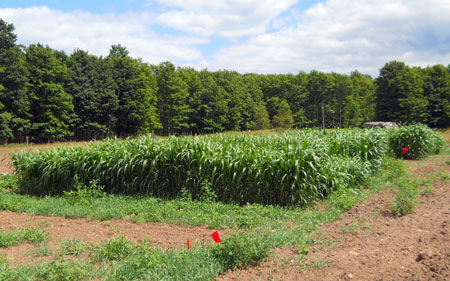Single species versus multiple species cover crops
Michigan’s Upper Peninsula trial explores option of multi-species cover crops for soil-building.
A replicated trial on a small farm in the north-central Upper Peninsula compared three cover crop selections and a fallow treatment. The project was funded by a Michigan State University Extension regional Project GREEEN grant. The cover crops included Marathon red clover, a hybrid sorghum sudangrass and a multi-species cover crop mixture from North Dakota containing soybeans, lentils, forage peas, sweet clovers, turnips, oil-seed radishes, pearl millets, forage oats and sunflowers.

U.P. cover crop trial, Rock River Farm, Alger County. July 27, 2011.
The cover crops were planted on June 29, 2011, and allowed to grow through the year with livestock grazing simulated by mowing off about half of the sorghum sudangrass and multi-species mixture in late September and leaving the mown material on the plots. This grazing was included to reproduce the way similar multi-species cover crops are currently managed on North Dakota farms.
After rototilling the cover crops in the spring of 2012, oats were planted. Oat yields were compared in August 2012 to determine the impact of the different soil-building cover crops after one year. Soil samples were also collected from each treatment before the trial, following the cover crop and following the oat crop. Soil test results were used to monitor soil fertility indicators, but were not meant to be conclusive and were not subjected to statistical analysis. No fertilizers were used in the trial.
Oat yield following the cover crop treatments in this trial gives a single indication of the impact of a single year cover crop treatment. Other factors, including weed suppression, were not included in this trial. This two-year trial was not expected to result in dramatic changes in crop yield or soil conditions. Cover crops are understood to be a long-term investment in soil health and crop performance with benefits becoming more apparent over several seasons.
Table 1. 2012 oat yield following 2011 cover crop treatments. Oats at 13.5 percent moisture. (20 percent level of significance indicates an 80 percent chance that yield differences were caused by treatments, not by chance.)
|
Cover crop treatment, 2011 |
Oat yield, 2012 bu/acre |
|
Fallow |
92 |
|
Red clover |
92 |
|
Sorghum sudangrass |
102 |
|
Multi-species |
109 |
|
Level of significance |
20 percent |
|
Least significant difference |
12 bushels |
The sorghum sudangrass and multi-species cover crop treatments resulted in better oat yields the following year, compared to red clover and fallow treatments. Soil testing before the trial showed a fertile soil high in organic matter. The organic matter dropped during and after the trial, probably due to thorough tillage of the pre-existing old sod prior to seeding cover crops and resulting oxidation and decomposition of raw organic matter. The inclusion of a cover crop can be expected to help maintain soil organic matter following the initial plow down of an old, dense sod and in following cropping years.
Cover crop seed cost and the impact of cover crop treatment on oat yield during the following year were used to create a simple economic comparison.
Table 2. Comparison of cover crop seed costs versus value of resulting oat yield
|
Cost of cover crop seed per acre (A) |
Oat yield above fallow treatment |
Value of oat yield at $3.85/bu above fallow treatment (B) |
B - A |
|
|
Fallow |
$0 |
0 bu/acre |
$0.00/acre |
$0.00 |
|
Red clover |
$33.12 |
0 bu/acre |
$0.00/acre |
-$33.12 |
|
Sorghum sudangrass |
$15.00 |
10 bu/acre |
$38.50/acre |
$23.50 |
|
Nitrogen Builder |
$24.00 |
17 bu/acre |
$65.45/acre |
$41.45 |
Conclusions of the trial:
- Oat yield was better following Nitrogen Builder cover crop treatment than following fallow or red clover cover crop treatments in 2012 on this trial site.
- There was not a statistically significant difference between oat yield following sorghum sudangrass and Nitrogen Builder cover crop treatments.
- Soil tests following the cover crop showed a modest increase in P, K, Mg, Ca and CEC under the Nitrogen Builder cover crop treatment. Soil organic matter, pH and lime index content were reduced.
- The Nitrogen Builder multi-species cover crop treatment compared favorably to the fallow and mono-culture cover crop treatments included in the trial.
The complete report of this project can be viewed at Comparing multi-species and mono-culture cover crop systems to improve soil fertility and crop performance in Michigan’s Upper Peninsula. You may also visit the MSU Cover Crop website for detailed cover crop information.
Please contact Extension educator Jim Isleib at 906-387-2530 for further information.



 Print
Print Email
Email




